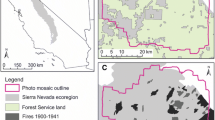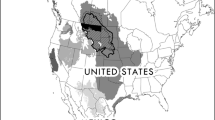Abstract
An important practical problem in the analysis of spatial pattern in ecological systems is that requires spatially-intensive data, with both fine resolution and large extent. Such information is often difficult to obtain from field-measured variables. Digital imagery can offer a valuable, alternative source of information in the analysis of ecological pattern. In the present paper, we use remotely-sensed imagery to provide a link between field-based information and spatially-explicit modeling of ecological processes. We analyzed one digitized color infrared aerial photograph of a serpentine grassland to develop a detailed digital map of land cover categories (31.24 m × 50.04 m of extent and 135 mm of resolution), and an image of vegetation index (proportional to the amount of green biomass cover in the field). We conducted a variogram analysis of the spatial pattern of both field-measured (microtopography, soil depth) and image-derived (land cover map, vegetation index, gopher disturbance) landscape variables, and used a statistical simulation method to produce random realizations of the image of vegetation index based upon our characterization of its spatial structure. The analysis revealed strong relationships in the spatial distribution of the ecological variables (e.g., gopher mounds and perennial grasses are found primarily on deeper soils) and a non-fractal nested spatial pattern in the distribution of green biomass as measured by the vegetation index. The spatial pattern of the vegetation index was composed of three basic components: an exponential trend from 0 m to 4 m, which is related to local ecological processes, a linear trend at broader scales, which is related to a general change in topography across the study site, and a superimposed periodic structure, which is related to the regular spacing of deeper soils within the study site. Simulations of the image of vegetation index confirmed our interpretation of the variograms. The simulations also illustrated the limits of statistical analysis and interpolations based solely on the semivariogram, because they cannot adequately characterize spatial discontinuities.
Similar content being viewed by others
References
Armstrong, A.C. 1986. On the fractal dimensions of some transient soil properties, J. Soil Sci. 37: 641–652.
Barbour, M.G., J.H. Burk, and W.D. Pitts. 1987. Terrestrial Plant Ecology (2nd ed.). Benjamin/Cummings Publishing Company, Inc., Menlo Park,CA.
Biondini, M.E. and C.E. Grygiel. 1994. Landscape distribution of organisms and the scaling of soil resources. Am. Nat. 143: 1026–1054.
Burrough, P.A. 1983a. Multiscale sources of spatial variation in soil. I. The application of fractal concepts to nested levels of soil variation. J. Soil Sci. 34: 577–597.
Burrough, P.A. 1983b. Multiscale sources of spatial variation in soil. II. A non-Brownian fractal model and its application in soil survey. J. Soil Sci. 34: 599–620.
Cliff, A.D. and J.K. Ord. 1981. Spatial Processes: Models andApplications. Pion, London.
Coffin, D. and W. Laurenroth. 1989. Disturbances and gap dynamics in a semiarid grassland: a landscapelevel approach. Land. Ecol. 3: 19–27
Cohen, W.B., T.A. Spies and G.A. Bradshaw. 1990. Semivariograms of digital imagery for analysis of conifer canopy structure. Remote Sens. Environ. 34: 167–178.
Cressie, N.A.C. 1993. Statistics for Spatial Data. Wiley, New York.
Curran, P.J. 1988. The semivariogram in Remote Sensing: an introduction. Remote Sens. Environ. 24: 493–507.
Curran, P.J. and J.L. Dungan. 1989. Estimation of signaltonoise: a new procedure applied to AVIRIS data. IEEE Trans. Geosci. Remote Sens. 27: 620–628.
Deutsch, C.V. and A.G. Journel. 1992. GSLIB. Geostatistical Software Library and User's Guide. Oxford University Press, New York.
Diggle, P.J. 1983. Statistical analysis of spatial point patterns. London, Academic Press.
Forman, R.T.T. and M. Godron. 1986. Landscape Ecology. J.Wiley and Sons, New York.
González, R.C. and P. Wintz. 1977. Digital Image Processing. AddisonWesley: Mass.
Hobbs, R.J. 1985. Harvester ant foraging and plant species distribution in annual grassland. Oecologia 67: 519–523.
Hobbs, R.J. and H.A. Mooney. 1985. Community and population dynamics of serpentine grassland annuals in relation to gopher disturbance. Oecologia 67: 342–351.
Hobbs, R.J. and V.J. Hobbs. 1987. Gophers and grassland: a model of vegetation response to patchy soil disturbance. Vegetatio 69: 141–146.
Hobbs, R.J. and H.A. Mooney. 1991. Effects of rainfall variability and gopher disturbance on serpentine annual grassland dynamics. Ecology 72: 59 68.
Huenneke, L., S. Hamburg, R. Koide, H. Mooney and P. Vitousek. 1990. Effects of soil resources on plant invasion and community structure in californian serpentine grassland. Ecology 71: 478–491.
Johnson, A.R., B.T. Milne and J.A Weins. 1992. Diffusion in fractal landscapes: simulations and experimental studies of tenbionid beetle movements. Ecology 73: 1968–1983.
Journel, A.G. and C.J. Huijbregts. 1978. Mining Geostatistics. Academic Press, London.
Jupp, D.L.B., A.H. Strahler and C.E Woodcock. 1988a. Autocorrelation and regularization in digital images. I. Basic theory. IEEE Trans. Geosci. Remote Sens. 26: 463–473.
Jupp, D.L.B., A.H. Strahler and C.E. Woodcock. 1988b. Autocorrelation and regularization in digital images. II. Simple image models. IEEE Trans. Geosci. Remote Sens. 27: 247–258.
Koide, R.T., L.F. Huenneke and H.A Mooney. 1987. Gopher mound soil reduces growth and affects ion uptake of two annual grassland species. Oecologia 72: 284–290.
Leduc, A., Y.T. Prairie and Y. Bergeron. 1994. Fractal dimension esimates of a fragmented landscape: sources of variability. Land. Ecol. 9: 279–286.
Levin, S.A. and R.T. Paine. 1974. Disturbance, patch formation, and community structure. Proc. Nat. Ac. Sci. U.S.A. 71: 2744–2747.
Levin, S.A. 1992. The problem of pattern and scale in ecology. Ecology 73: 1943–1967.
Lobo, A. 1997. Image segmentation and discriminant analysis for the identification of landscape units in ecology. IEEE Trans. Geosci. Remote Sens. (forthcoming)
Lobo, A., N. Chiariello and K. Moloney. (In press). Finescale mapping of a grassland from digitized aerial photography: an approach using image segmentation and discriminant analysis. Int. J. Remote Sensing.
Mandelbrot, B.B. 1983. The fractal geometry of nature. W. H. Freeman & Co., San Francisco.
Matheron, G. 1965. La Théorie des variables régionalisées et ses applications. Masson, Paris.
Mark, D.M. and P.B. Aronson. 1984. Scaledependent fractal dimensions of topographic surfaces: An empirical investigation, with applications in geomorphology and computer mapping. Math. Geol. 16: 671–683.
McNaughton, S.J. 1968. Structure and function in California grasslands. Ecology 49: 962–972.
Milne, B.T. 1991. Lessons from applying fractal models to landscape patterns. In QuantitativeMethods in Landscape Ecology, pp. 199–235. Edited by M.G. Turner and R.H. Gardner. SpringerVerlag, New York.
Milne, B.T. 1992. Spatial aggregation and neutral models in fractal landscapes. Am. Nat. 139: 32–57
Milne, B.T., K.M. Johnston and R.T.T. Forman. 1989. Scale dependent proximity of wildlife habitat in a spatiallyneutral Bayesian model. Land. Ecol. 2: 101–110.
Moloney, K.A. 1993. Determining process through pattern: reality or phantasy? In Patch Dynamics. pp. 61–69. Edited by S.A. Levin, T. Powell and J. Steele. Lecture Notes in Biomathematics nb. 96, SpringerVerlag, Berlin.
Moloney, K.A. and S.A. Levin. 1996. The effects of disturbance architecture on landscape level population dynamics. Ecology (in press).
Moloney, K., A Morin and S.A. Levin. 1991. Interpreting ecological patterns generated through simple stochastic processes. Land. Ecol. 5: 163–174.
Murphy, D.D. and P.R. Erlich. 1989. Conservation biology of California's remnant grasslands. In Grassland Structure and Function: California Annual Grassland. pp. 201–211. Edited by L.F. Huenneke and H. Mooney. Kluwer Academic Publishers, Dordrecht.
Oliver, M.A. and R. Webster. 1986. Semivariograms for modelling the spatial pattern of landform and soil properties. Earth Surface Processes and Landforms 11: 491–504.
O'Neill, R.V., B.T. Milne, M.G. Turner and R.H. Gardner. 1988. Resource utilization scales and landscape pattern. Land. Ecol. 2: 63–69.
Palmer, M.W. 1988. Fractal geometry: a tool for describing spatial patterns of plant communities. Vegetatio 75: 91–102.
Palmer, M.W. 1990. Spatial scale and patterns of species-environment relationships in hardwood forest of the North Carolina piedmont. Coenoses 5: 79–87.
Palmer, M.W. 1992. The coexistence of species in fractal landscapes. Am. Nat. 139: 375–397.
PardoIguzquiza, E. and M. ChicaOlmo. 1993. The Fourier integral method: an efficient spectral method for simulation of random fields. Math. Geol. 25: 177 217.
Pastor, J. and W.M. Post. 1988. Response of northern forests to CO2induced climate change. Nature 334: 55–58.
Pianka, E. 1978. Evolutionary Ecology (Second ed.). Harper & Row, Publishers, New York, NY.
Price, J.C. and W.C. Bausch. 1995. Leaf area index estimation from visible and nearinfrared reflectance data. Remote Sens. Environ. 52: 55–65
Ramstein, G. and M. Raffy. 1989. Analysis of the structure of radiometric remotelysensed images. Int. J. Remote Sensing 10: 1049–1073.
Reed, R.A., R.K. Peet, M.W. Palmer and P.S. White. 1993. Scale dependence of vegetation-environment correlations: a case study of a North Carolina piedmont woodland. J.Veg. Sci. 4: 329–340.
Richards, J.A. 1993. Remote sensing digital image analysis. An introduction. SpringerVerlag, Heidelberger.
Ripley, B.D. 1981. Spatial Statistics. Wiley, New York.
Robertson, G.P. 1987. Geostatistics in ecology: interpolating with known variance. Ecology 68: 744–748.
Robertson, G.P., M.A. Huston, F.C. Evans and J.M. Tiedje. 1988. Spatial variability in a successional plant community: patterns of nitrogen availability. Ecology 69: 1517–1524.
Rossi, R.E., D.J. Mulla, A.G. Journel and E.H. Franz. 1992. Geostatistical tools for modeling and interpreting ecological spatial dependencedependence. Ecol. Monog. 62: 277–314.
Saupe, D. 1988. Algorithms for random fractals, In The Science of fractal images. pp. 71–136. Edited by H.O. Peitgen and D. Saupe. Springer, New York.
Statistical Sciences 1993. SPLUS Programmer's Manual, Version 3.2, Seattle: StatSci, a division of MathSoft, Inc. 1993.
Steele, J.H. 1978. Some comments on plankton patchiness. Spatial patterns in plankton communities. Plenum Press, New York.
Tilman, R. 1982. Resource competition and community structure. Princeton University Press, Princeton, NJ.
Turner, M.G. 1987. Landscape Heterogeneity and Disturbance. SpringerVerlag, New York.
Turner, M.G. 1989. Landscape Ecology: the effect of pattern on process. Ann. Rev. Ecol. Sys. 20: 171–197.
Turner, S.J., R.V. O'Neill, W. Conley, M.R. Conley and H.C. Humphries. 1991. Pattern and Scale: Statistics for Landscape Ecology. In Quantitative Methods in Landscape Ecology. pp. 17–50. Edited by M.G. Turner and R.H. Gardner. SpringerVerlag, New York.
Upton, G.J.G. and B. Fingleton. 1985. Spatial Data Analysis by Example, Volume 1: Point Pattern and Quantitative Data. Wiley, Chichester.
Urban, D.L., R.V. O'Niell and H.H. Shugart. 1987. Landscape Ecology. BioScience 37: 119–127.
U.S. Army Corps of Engineers 1991. GRASS 4.0 User's Regerence Manual. U.S. Army Contruction Engineering Research Laboratory, Champaign, Illinois. 513 pp.
Voss, R.F. 1988. Fractals in nature: From characterization to simulation. In The Science of fractal images. pp 21–70. Edited by H.O. Peitgen and D. Saupe. Springer, New York.
Walker, R.B. 1954. The ecology of serpentine soils: II. Factors affecting plant growth on serpentine soils. Ecology 35: 259–266.
Watt, A.S. 1947. Pattern and process in the plant community. J. Ecol. 35: 1–22.
Webster, R., P.J. Curran and J.W. Munden. 1989. Spatial correlation in reflected radiation from the ground and its implications for sampling and mapping by ground-based radiometry. Remote Sens. Environ. 29: 67–78.
Webster, R. and M.A. Oliver. 1990. Statistical methods in soil and land resource survey. Oxford University Press, Oxford.
Whittaker, R.H. 1975. Communities and Ecosystems, 2d ed. Macmillan, New York.
Whittaker, R.H. and S.A. Levin. 1977. The role of mosaic phenomena in natural communities. Theor. Pop. Biol. 12: 117–139.
Wiens, J.A. 1989. Spatial scaling in ecology. Funct. Ecol. 3: 385–397.
Woodcock, C.E., A.H. Strahler and D.L.B. Jupp. 1988a. The use of variograms in Remote Sensing: I. Scene models and simulated images. Remote Sens. Environ. 25: 323–348.
Woodcock, C.E., A.H. Strahler and D.L.B. Jupp. 1988b. The use of variograms in Remote Sensing: II. Real digital images. Remote Sens. Environ. 25: 349–379.
Wu, J. and S.A. Levin. 1994. A spatial patch dynamic modeling approach to pattern and process in an annual grassland. Ecol. Monog. 64: 447–464.
Author information
Authors and Affiliations
Rights and permissions
About this article
Cite this article
Lobo, A., Moloney, K., Chic, O. et al. Analysis of fine-scale spatial pattern of a grassland from remotely-sensed imagery and field collected data. Landscape Ecology 13, 111–131 (1998). https://doi.org/10.1023/A:1007938526886
Issue Date:
DOI: https://doi.org/10.1023/A:1007938526886




